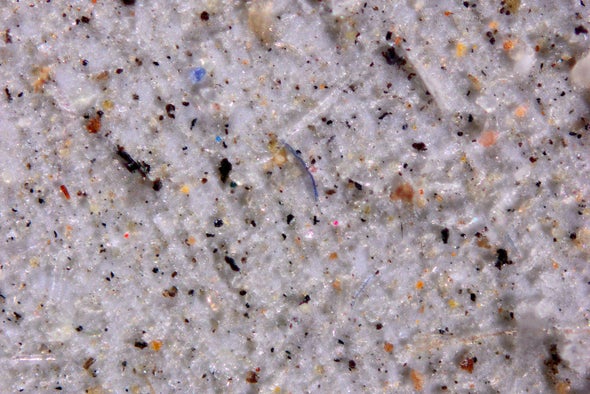Thousands of Tons of Microplastics Are Falling from the Sky
Published on by Water Guardian Research in Science
New research helps unravel how vast amounts of plastic particles travel—both regionally and globally—on the wind

Plastic fibers and beads in dusts collected from remote National Parks and Wilderness areas in the United States. Credit: Janice Brahney Utah State University
Carried by the wind, dust particles from places such as the Sahara Desert can float halfway around the world before settling to the ground. As the plastics discarded by humans break down into tiny pieces in the environment, they, too, drift through the atmosphere. Now scientists are a step closer to understanding how these globe-trotting microplastics travel—both locally and on long-distance flights.
Researchers spent more than a year collecting microplastics from 11 national parks and wilderness areas in the western U.S. They separately examined the particles that settled on dry days and those that fell along with rain or snow. In addition to shedding light on how microplastics move around, the results, published on Thursday in Science , reveal the sheer scale of the problem: more than 1,000 metric tons of microplastics—the weight of 120 million to 300 million plastic water bottles—fall on protected lands in the country’s western region each year. The new findings add to scientists’ concern over microplastic pollution’s potential impacts on the environment and human health. “We’re not supposed to breathe in this material,” says Steve Allen, a microplastics researcher at the University of Strathclyde in Scotland, who was not involved in the new study. Plastics in the environment “carry all sorts of pesticides, heavy metals and all the other chemicals that we've made over time,” he adds. “They're going to carry them directly into our lungs.”
Since their discovery in oceans in the 1970s, microplastics—which can be as large as a grain of rice or smaller than a particle of dust—have been found nearly everywhere researchers have looked: in cities, in Arctic snow, on remote mountaintops. Their presence in areas distant from human habitation has pointed to them being borne by winds. Few studies have directly investigated this possibility, however.
Janice Brahney, a watershed scientist at Utah State University and lead author of the new study, initially set out to investigate how dust carries nutrients, not plastic. But after peering into her microscope and seeing colorful beads and fibers among the bits of dust, she refocused her efforts. To collect microplastic samples, Brahney’s team used a pair of 3.5-gallon (13.2-liter) buckets with a sensor-triggered lid. When rain or snow fell, the lid would cover the “dry” bucket and allow material to enter the “wet” one. During dry weather, the lid would cover the wet bucket and allow material to enter its dry counterpart.
Back in the lab, the researchers counted the plastic particles by hand under a microscope, using visual clues such as vivid colors and unnatural textures to distinguish them from dust and organic materials. The team independently estimated the number of microplastics using a process called Fourier transform infrared spectroscopy, which measured how the samples absorbed and emitted infrared light to differentiate plastic from other material. The particles and fibers they captured originated as carpeting, paint, cosmetic products, camping gear, and more. But the largest contribution came from clothing. Clothes shed microfibers when they are washed and dried, as well as during daily use.
The scientists found microplastics in almost every sample they collected. In total, 4 percent of the identifiable dust particles were plastic. Brahney and her colleagues “immediately realized the gravity of what we were seeing,” she says. “That was a moment of being just completely astounded.”
By analyzing weather patterns and dust accumulation in the national parks and wilderness areas, the team could observe the effects of pollution from nearby cities—and could better understand the “plastic cycle” that carries synthetic materials across the planet, just as the “dust cycle” transports dust. The microplastics that fell to the ground during storms tended to be larger and arrived when winds blew in from populated areas. This observation indicated that the “wet” plastics originated in those nearby cities and that larger plastics fall out of the atmosphere closer to where they are emitted. On the other hand, the microplastics that fell during dry conditions were smaller but more numerous. They also corresponded with air currents higher in the atmosphere, suggesting that these plastics had traveled long distances.
The new research “expanded quite significantly” on previous studies of microplastics in remote areas, Allen says, including a paper he and his wife, Deonie Allen, also at the University of Strathclyde, published last year in Nature Geoscience . “They’ve done a nice job of especially working out where it came from and the sort of distances it can travel,” he adds. Deonie Allen, who was not involved with Brahney’s project, says that the separation of dry and wet microplastics represents an important advance toward understanding how atmospheric conditions affect the flight paths of these particles.
For Brahney and others, future research will focus on uncovering the ways microplastics enter the atmosphere. “We’re only starting to really scratch the surface of what is in the atmosphere and how it's moving around,” she says.
Source: Scientific American
Taxonomy
- Fibers & Textiles
- microplastics